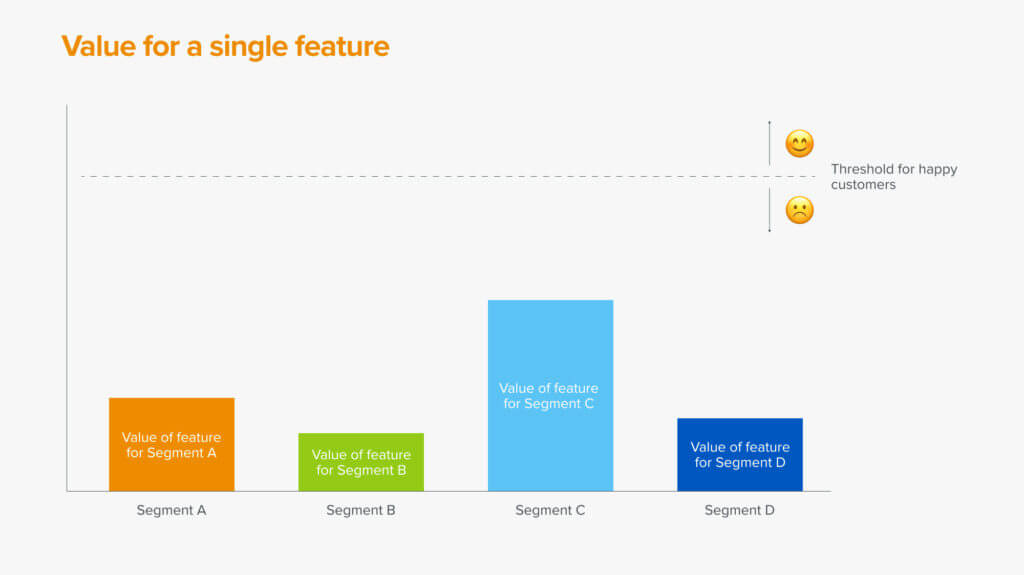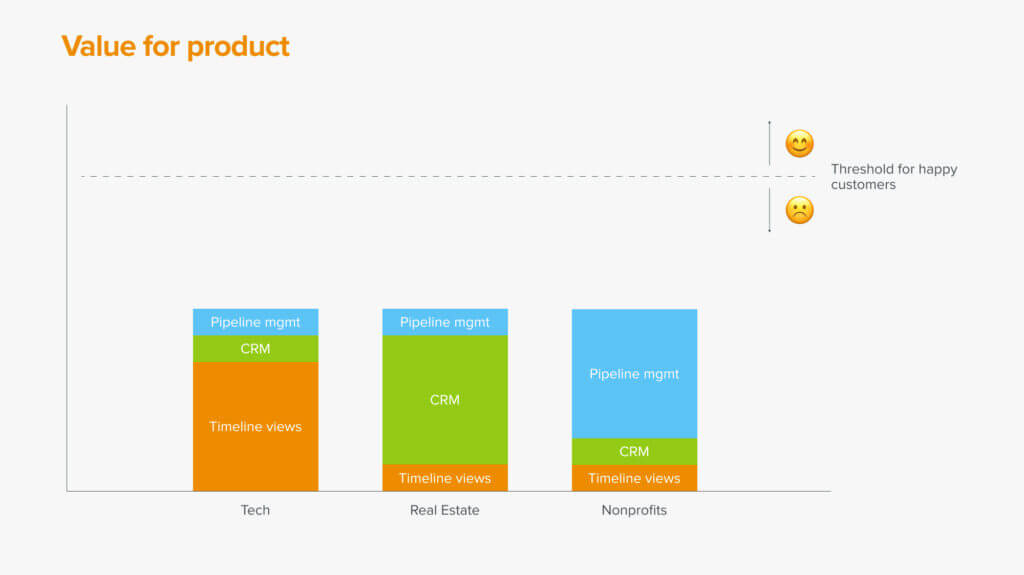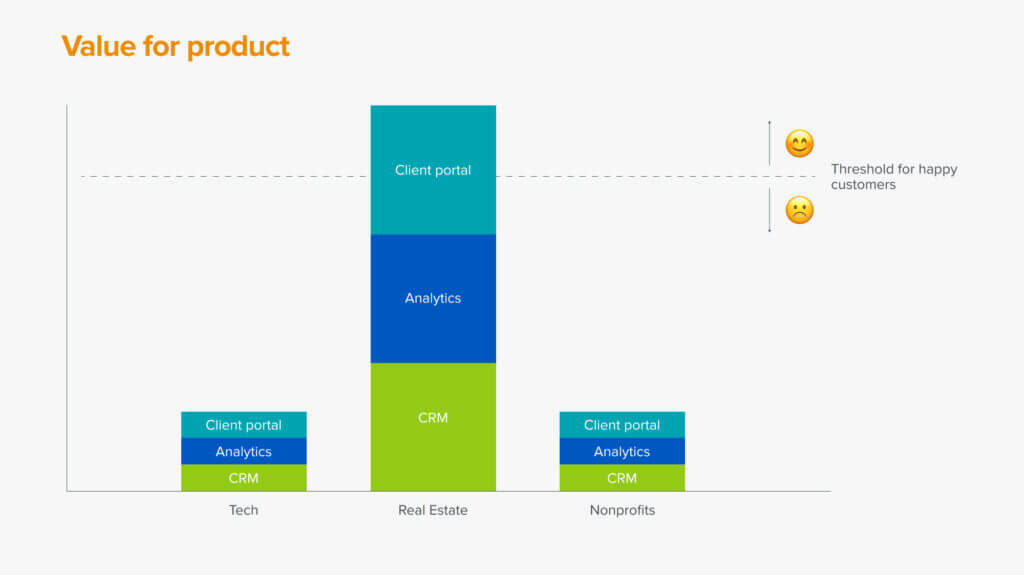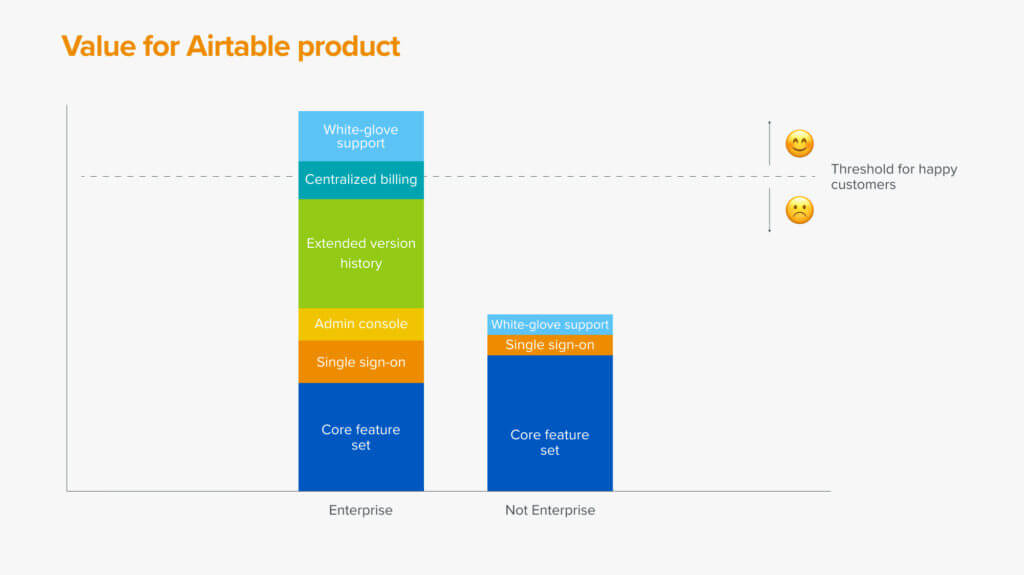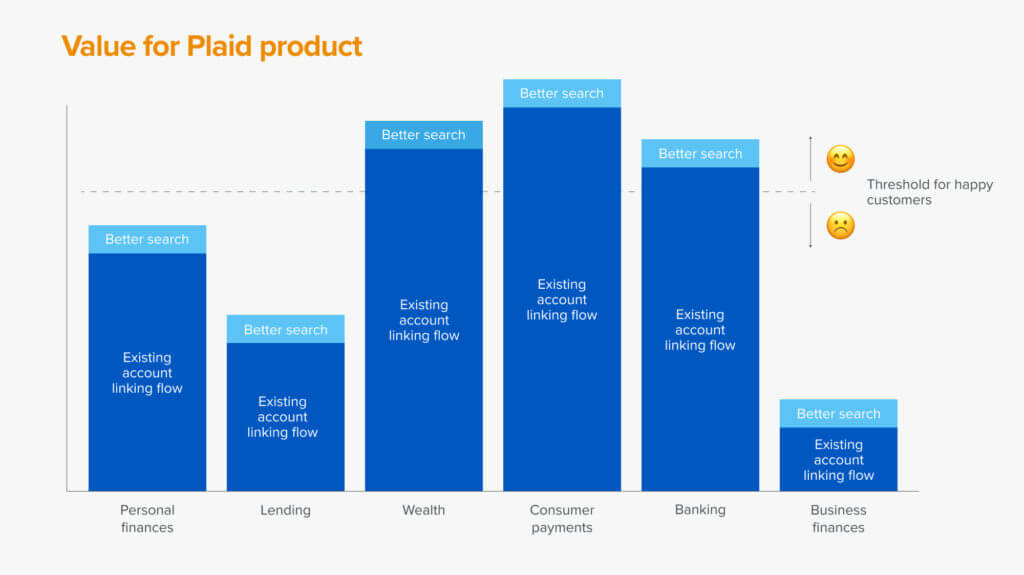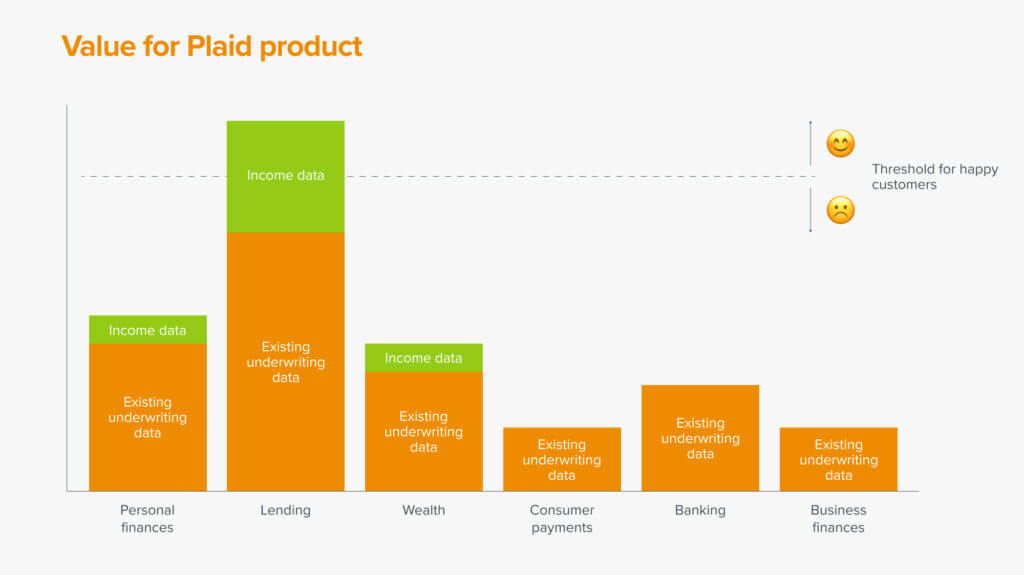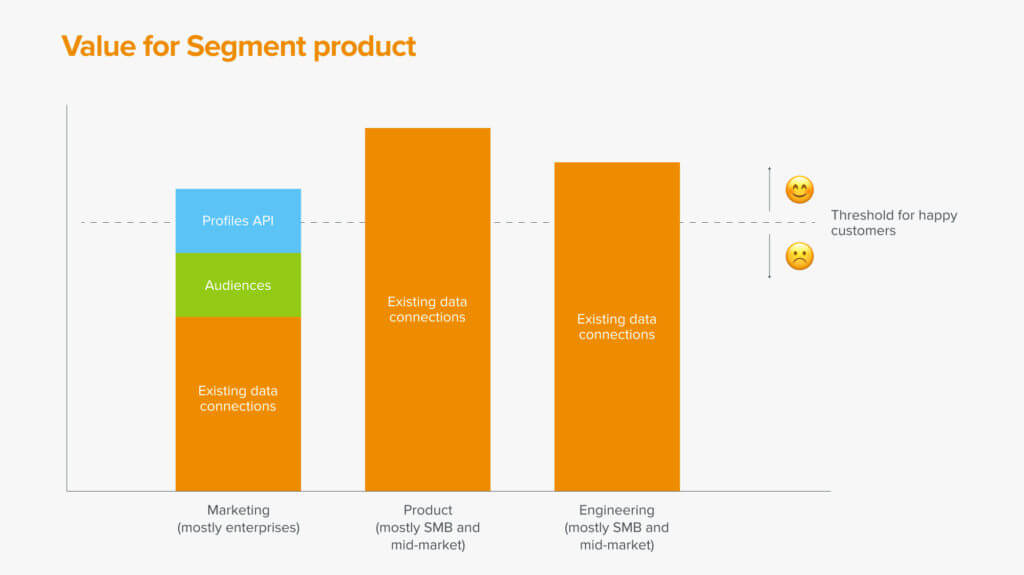Founders and company leaders take for granted that customer segmentation is important. However, those less experienced with the nuances of segmentation often don’t appreciate why segmentation is important, and as a result, fail to realize the business and organizational benefits of doing segmentation well. We believe the upside can be especially rewarding for B2B companies (but is universally applicable), and our intention with this piece is to explore the why and make it more intuitive.
The short version is that segmentation is a powerful tool for driving product success, and an effective means to align the priorities of product teams and go-to-market (GTM) teams. It unifies conversations and debates around “what you’re building” and “what you’re selling.”
When teams aim to cultivate happy customers within segments, they prioritize features that stack value to dominate a segment. This avoids the pitfall of spreading the value of features across many segments and ending up with many lukewarm—but few happy—customers. To do this well, product and GTM teams must align upfront on what customer attributes make sense to guide product improvements and inform GTM motions.
Definitions
Customer segmentation
Think of customer segmentation as dividing up the broad customer base into smaller subsets based on common needs for the product. It’s critical to define “needs-based segments” to ensure you organize customers in a way that reflects their different behaviors. Needs can correlate to factors such as industry vertical, company size, buyer persona, use case, geographic location, etc., so it’s important to think critically about which factors truly reflect behaviors. We often see segmentation go wrong when customers are grouped in a way that’s convenient for the company, but doesn’t correspond to how those customers purchase and use the product.
The surface-level rationale for segmentation is that it’s useful to divide up the customer base to customize and organize go-to-market efforts. For example, an account executive who always talks to customers in the same vertical may develop a more nuanced understanding of their pain points. We believe that in addition to adding focus to go-to-market efforts, customer segmentation helps prioritize product development efforts in a way that nurtures more happy customers.
Happy customer
A happy customer is one who:
- Refers your product to others.
- Engages with you and gives you feedback.
- Uses your product intensely and gives you data/insights on how to make it better.
- Ultimately generates revenue to fund future investment in the product.
Product success is a function of the number of happy customers, not simply a function of the total value created across all customers. Often, founders set the bar too low for what comprises a happy customer; the reality is that if they’re not referring the product or giving feedback, they don’t meet the bar. Companies should carry the ethos that having one happy customer is more worthwhile than 10 lukewarm customers—this is especially true for early stage startups.
Value and cost
How can we “measure” if a customer is happy? Consider that every customer has their own perceptions for value and cost for a product. Value could be how much a customer is willing to pay for your product. Cost could be the price you’re charging along with the time and effort it takes to get implemented. If a customer perceives that value exceeds cost, they will buy your product. You have a happy customer when value significantly exceeds cost. Thus, we’ll focus primarily on how decisions impact value creation.
Prioritize features that resonate with the same segment to cultivate happy customers
To explain our theory, we like to use a framework that maps the value of products and features to different customer segments.
A new feature doesn’t necessarily increase the value of the overall product uniformly across all customers. More likely, one segment is intensely requesting that feature, so it will disproportionately increase value for that segment. We can assume customers in the same segment derive similar value from a feature. To show this, we assign a quantity of “value” for each customer segment, representing the average customer in a segment (as there will still be a distribution of value across customers within the segment). We also assume cost is constant across segments. From this, we define a happy customer as one whose value exceeds a certain threshold.
We show this in the diagram below:
This feature has the biggest impact on Segment C. We can describe a product to be the combination of a number of features; thus, value for a product is the total value of the component features. The hope is that this new feature, in conjunction with existing features, will nurture more happy customers in Segment C. This is how new product features translate to GTM impact.
Divergent outcomes based on different priorities
To bring this framework to life, let’s consider a hypothetical SaaS company building a project management tool (imagine an early version of ClickUp or Monday.com), and explore how different prioritization approaches lead to different numbers of happy customers.
Suppose the company has built out the basic table-stakes functionalities, and is now thinking about how to prioritize three “killer” features. Its three main customer segments are tech, real estate, and nonprofits. It finds that the most requested feature for the tech segment is timeline views (for product roadmaps); for real estate, it’s a customer relationship management module (for tenants); for nonprofits, it’s pipeline management (for grants). In an attempt to cater to each segment, the company might choose to prioritize these three features.
The resulting diagram will look like this:
Working with the GTM team, the product team learns that the real estate segment also intensely requests analytics (to forecast occupancy rates) and a client portal (to communicate with tenants). The company might choose to prioritize the three real-estate specific features instead, to create happy customers within the real estate segment.
The resulting diagram will look like this:
In both cases, the product is a combination of three features and the total value created is equal. However, in the first case, there are no happy customers in any of the segments. In the second, the company has cultivated happy customers in the real estate segment.
The contrast between the two outcomes shows why it’s important for GTM and product teams to be aligned. When the teams are uncoordinated, the product being built and the product being sold diverge; there are no happy customers. Performing a customer segmentation exercise together forces both sides to be aligned on customer needs and priorities. GTM teams and product teams need to discover together how different segments value the same features, and product teams need to be transparent with GTM teams about the process used to prioritize features.
Aligned teams are more intentional about which features to prioritize, instead of simply responding to all feature requests. They can still build features that appeal to the entire customer base, but they end up prioritizing features concentrated on a segment to dominate it, as opposed to peanut-buttering the value of new features across many segments. This fidelity of decision-making assumes the company is considering the right sets of features in the first place, which is predicated on having strong product and GTM alignment. This becomes even more important as the company grows and becomes successful, because eventually you’ll start seeing entire companies focused on serving only one of your segments.
At the same time, the exercise clarifies which segments NOT to serve. In the second case, when client portal is being considered, it’s clear that the tech and nonprofit segments are not the ones to prioritize. Saying no to customers is one of the hardest things for a company to do, but in reality companies don’t say no to enough customers. This is why aligning on an “Ideal Customer Profile” (ICP) is so beneficial. When the company decides to focus on real estate as the ICP and cultivate happy customers in this segment, it makes it easier to say no to less impactful feature requests from the tech and nonprofit segments.
Different ways to segment
While segmenting by industry verticals, like we did in the example above, can be an effective approach, there are many other ways to define needs-based segments.
Company size
Consider a product like Airtable, which can be adopted and purchased bottom-up by individuals and small teams, but also sold top-down to larger enterprises. Hence, a simple segmentation is to divide customers into enterprise and not enterprise.
We often do this intuitively by bucketing many features into the category of “enterprise ready.” Implicitly, we’re segmenting customers between enterprise and not enterprise because we know certain features only increase value for the enterprise segment. These can include single sign-on, admin console, extended version history, centralized billing, white-glove support, etc.
We can represent these features on our diagram (note that some features have zero value to the not enterprise segment):
Use cases
Now let’s explore a more nuanced example: segmenting by use cases. Consider a product like Plaid, which as a “building block” product will have wide appeal across a diverse range of customers. Plaid may notice its customers tend to build within a number of common use cases for their end-customers. Let’s use the segments that Plaid outlines on its website: personal finances, lending, wealth, consumer payments, banking, and business finances.
Suppose the product team wants to boost search quality for its account-linking flow because it’s important to improve the success rate on account connections. Successful connections are important for all the segments; therefore, the total value increase will be significant. However, segments already highly value the existing account linking flow; as a result, they only perceive the improvement from better search as marginal.
The resulting diagram will look like this:
Across the use cases, better search has limited impact in creating new happy customers. A go-to-market team can raise this to the product team.
Alternatively, suppose the product team wants to invest in a new set of integrations for more comprehensive and reliable income data. This data is mostly useful for customers in the lending segment (some customers in personal finances and wealth could also find some value). These lending customers have a strong need for this data because they believe it will drastically improve their underwriting models, compared to having only asset data currently. In fact, while the lending segment gets much value with the existing underwriting data, it’s not quite enough to engender happiness.
The resulting diagram will look like this:
Value for the lending segment increases significantly, creating many new happy customers. Again, the go-to-market team should be able to share this acute segment need with the product team and anticipate the impact on happy customers.
Evolving segmentation over time
An even more nuanced example is updating the segmentation approach as the product matures. Consider a product like Segment (which is a platform to collect customer data). Let’s say that, early on, it found the most effective approach was to divide customers into startups and enterprises. As the company had more success selling to enterprises, the GTM team had the insight that within enterprises, the marketing buyer commands much larger budgets than the technical teams and has different feature requests. The product team has had these marketing-centric features on their roadmap, but historically found them difficult to prioritize. However, both teams now realize that building these features will unlock these large marketing budgets.
So, together, the product and GTM teams decide that the better way to segment is by buyer personas. Let’s use the ones on Segment’s website: marketing, product, and engineering (implicitly, each buyer persona still has some correlation with company size). Product and engineering teams already perceive significant value in the existing data connections product. However, marketing teams want to use the data from these connections to deliver personalized campaigns. They need two key features: Audiences to group users based on events and traits, and a profiles API to programmatically sync these audiences with their marketing tools.
The resulting diagram will look like this:
These two features increase value only for the marketing segment, but it will create many new happy customers in that lucrative segment.
As the segmentation approach evolves, so will the ICP definition. Companies should continually evaluate who they want to serve and who they should say no to. We find that this is especially useful when they are spending more time moving upmarket, to ensure both product and GTM teams are aligned about the transition.
Aligning product and GTM teams
As we’ve shown throughout our examples, teams can prioritize features vastly differently depending on their objectives. Where product success is achieved by creating happy customers, teams should prioritize segment-centric features that stack value in a concentrated way. This can only be done effectively if the team knows the value impact of each feature on each segment.
The product team alone has an imperfect calibration of these inputs. To inform the prioritization, the product team must collaborate with the GTM team. The GTM team has a constant pulse on the needs of both existing and prospective customers, and they can also discuss the upcoming roadmap with customers to gather feedback. They can aggregate their insights and share them with the product team. The GTM team is highly incentivized to capture this accurately, because then the product team will ship features that the GTM team can take back to the customers.
This is an iterative process between the product and GTM teams that aligns their priorities. The crux of our belief is that the foundational ingredient that makes this iterative process successful is product and GTM aligning on the right needs-based segments. When the two teams have the same mental model for how they divide up the broader customer base, they can focus on the same segments and speak the same language when processing feedback, prioritizing features, and tailoring GTM motions.
Thus, the segmentation exercise itself is one that product and GTM teams should do together. The failure mode is when product teams prioritize roadmaps in their own silo while GTM teams perform segmentations with the sole objective of making their motions more efficient—the company ends up in a situation where customers are constantly, gradually disappointed by their needs not being met.
Bringing it back together
We hope this framework of mapping the value of products and features to customer segments illustrates not only why segmentation is important, but also the upside of doing it well. To perform segmentation well, the product and GTM teams must be aligned throughout the process, from defining the segments, to identifying feature needs, to understanding how each segment values potential features.
We’ll be the first to admit there are many nuances we didn’t touch on. For example, there’s much finer analysis one can do on differing value and cost within the same segment, as well as for different monetization models (e.g., freemium and usage-based); we’ve made many simplifying assumptions.
Still, we hope we’ve made the why behind the importance of segmentation a lot more intuitive, and will encourage discussions between your product and GTM teams. Every product and GTM leader we’ve spoken to about this topic has expressed the sentiment that a stronger relationship between their product and GTM teams would lead to both better product success and more happy customers.
We also believe there is opportunity for an entire category of startups to streamline these processes between product and GTM teams. If you’re building in this area, feel free to reach out to zyang at a16z dot com.
Thanks to Calvin French-Owen for helping us crystalize select examples. Also thanks to Kristina Shen and Joe Morrissey for their wisdom and feedback during the writing process.


